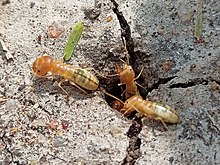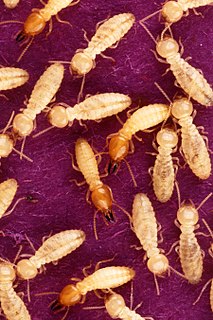
Termites are eusocial insects that are classified at the taxonomic rank of infraorder Isoptera, or as epifamily Termitoidae within the order Blattodea. Termites were once classified in a separate order from cockroaches, but recent phylogenetic studies indicate that they evolved from cockroaches, as they are the sister group to wood eating cockroaches of the genus Cryptocercus. Previous estimates suggested the divergence took place during the Jurassic or Triassic. More recent estimates suggest they have an origin during the Late Jurassic, with the first fossil records in the Early Cretaceous. About 3,106 species are currently described, with a few hundred more left to be described. Although these insects are often called "white ants", they are not ants, and are not closely related to ants.

Mastotermes darwiniensis, common names giant northern termite and Darwin termite, is a termite species found only in northern Australia. It is the most primitive extant termite species.

Mastotermes is a genus of termites. The sole living species is Mastotermes darwiniensis, found only in northern Australia. A number of extinct taxa are known from fossils. It is a very peculiar insect, the most primitive termite alive. As such, it shows notable similarities to certain cockroaches, the termites' closest relatives. These similarities include the anal lobe of the wing and the laying of eggs in bunches, rather than singly. The termites were traditionally placed in the Exopterygota, but such an indiscriminate treatment makes that group a paraphyletic grade of basal neopterans. Thus, the cockroaches, termites and their relatives are nowadays placed in a clade called Dictyoptera.
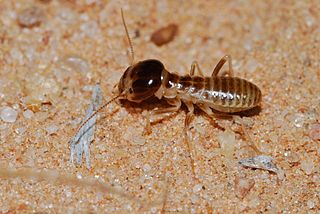
The harvester termites are an ancient, Old World family of termites, the Hodotermitidae. They are distinguished by the serrated inner edge of their mandibles, and their functional compound eyes which are present in all castes. They forage for grass at night and during daylight hours, and pigmented workers are often observed outside the nest. Their range includes the deserts and savannas of Africa, the Middle East, and Southwest Asia. Their English name refers to their habit of collecting grass, which is not unique to the family, though.

Hodotermes is a genus of African harvester termites in the Hodotermitidae. They range from Palaearctic North Africa, through the East African savannas to the karroid regions of southern Africa. As with harvester termites in general, they have serrated inner edges to their mandibles, and all castes have functional compound eyes. They forage for grass at night and during the day, and their pigmented workers are often observed outside the nest.

Microhodotermes is a genus of southern African harvester termites in the Hodotermitidae. As with harvester termites in general, they have serrated inner edges to their mandibles, and all castes have functional compound eyes. Species of this genus are desert specialists of the Namib, Kalahari and Karoo, where their ranges overlap with Hodotermes.

Psammotermes allocerus Silvestri, 1908 is a sand termite that lives in the deserts of Namibia and neighboring countries. They were thought to be responsible for the creation of fairy circles, until that theory was disproven in 2013.

Psammotermes is a genus of termites in the family Rhinotermitidae. It is found living in subterranean nests in arid parts of Africa.
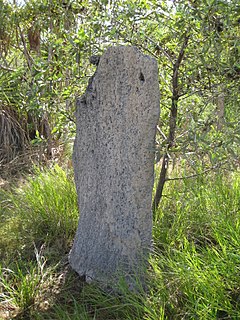
Amitermes is a genus of termites in the family Termitidae. It is the second largest genus after Microcerotermes in the subfamily Amitermitinae with around one hundred species. Species are found in a range of habitats including deserts and rainforests. Characteristics of Amitermes soldiers include a bulbous head, sickle-shaped mandibles with a single tooth on their inner margins and cephalic glands on the front of their heads.
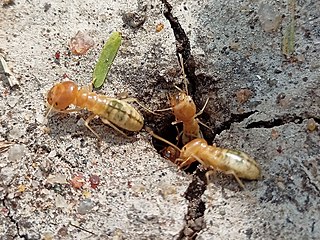
Anacanthotermes viarum is a species of harvester termite in the family Hodotermitidae. It is found in India and Sri Lanka. It is a grass feeder.
Neotermes greeni, is a species of drywood termite of the genus Neotermes. It is native to India and Sri Lanka. It closely resembles Postelectrotermes militaris. It is a minor pest of tea in Sri Lanka, and major pest of mango in India.
Cryptotermes bengalensis, is a species of dry wood termite of the genus Cryptotermes. It is native to India, Bangladesh, Thailand and introduced to Sri Lanka. It is found in dead and rotten wood of Ficus species. It is a pest of Diospyros insignis.
The Indo-Malaysian drywood termite,, is a species of dry wood termite of the genus Cryptotermes. It is found in Philippines, Australia, Papua New Guinea, Hawaii, and introduced to Sri Lanka. It is the smallest termite species in Australia, with 2.5 – 3.7mm in soldiers.
Coptotermes emersoni, is a species of subterranean termite of the genus Coptotermes. It is native to India, Sri Lanka, and Vietnam. Though it is a wood destroying termite, it was first found from an electrical wire case in the National Museum of Colombo.
Odontotermes escherichi, is a small species of termite of the genus Odontotermes. It is native to India, Sri Lanka and Peninsular Malaysia. It attacks many dead, tree stems and decaying logs.
Hospitalitermes monoceros, is a species of nasute termite of the genus Hospitalitermes. Earlier, it was considered to be endemic to Sri Lanka, but discovered from India in 2013. It is an obligate lichen feeder. It is recorded from Cassia multijuga and Ficus religiosa trees and is a pest of tea.
The Snouted harvester termite,, is a species of mound building termite of the genus Trinervitermes. It is native to India and Sri Lanka. Type species was described from Bandarawela area of Sri Lanka. It is a pest of sugarcane, and brinjal.
Microcerotermes bugnioni, is a species of small termite of the genus Microcerotermes. It is found from Seenigoda Estate of Sri Lanka. It can be found under logs and in hollow stems of coconut palms.
Microcerotermes heimi, is a species of small termite of the genus Microcerotermes. It is found from Maharashtra area of India and from Sri Lanka. It can be found from forests, in dead stumps and under bark of trees.

Blattoidea is a superfamily of cockroaches and termites in the order Blattodea. There are about 17 families and more than 4,100 described species in Blattoidea.
